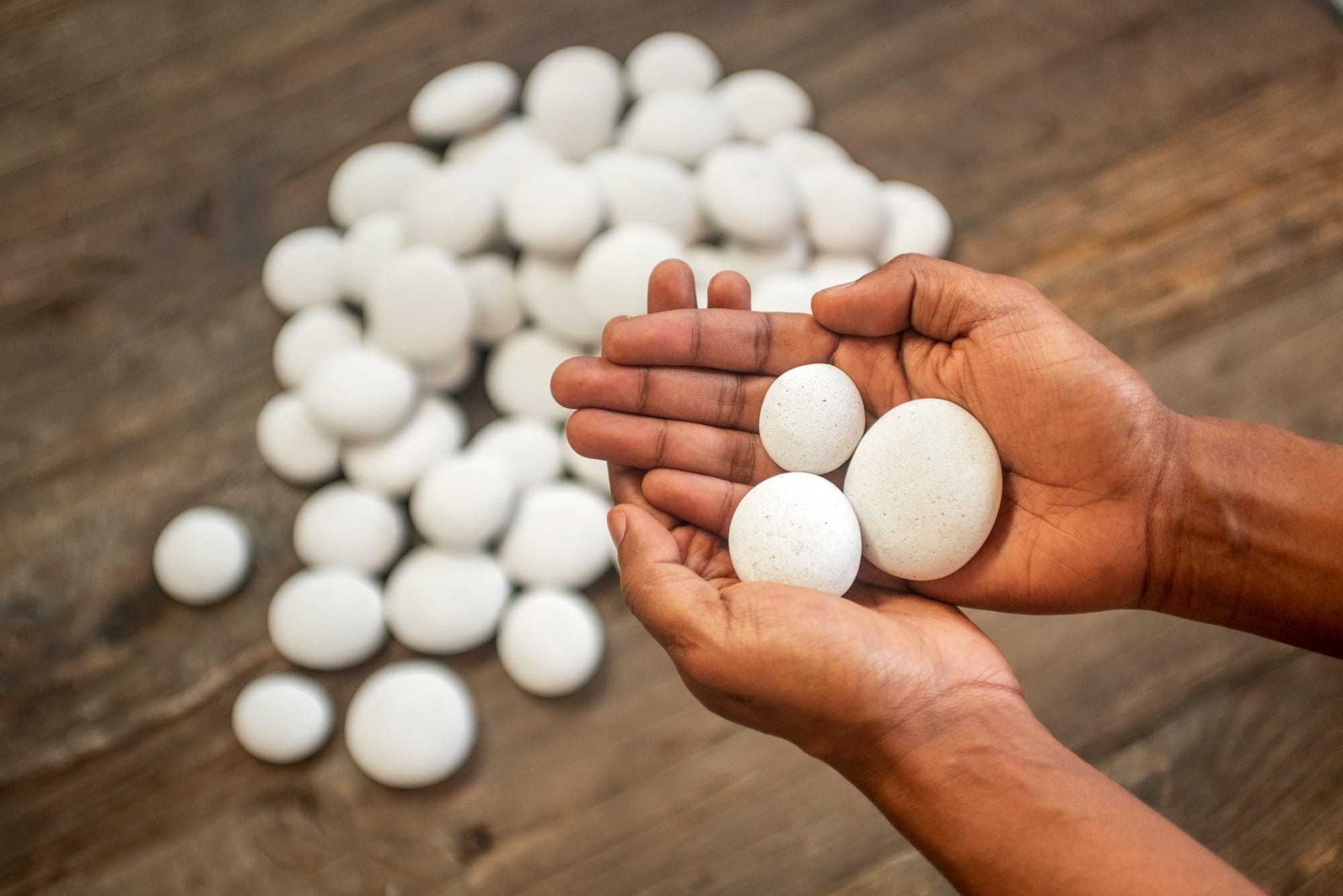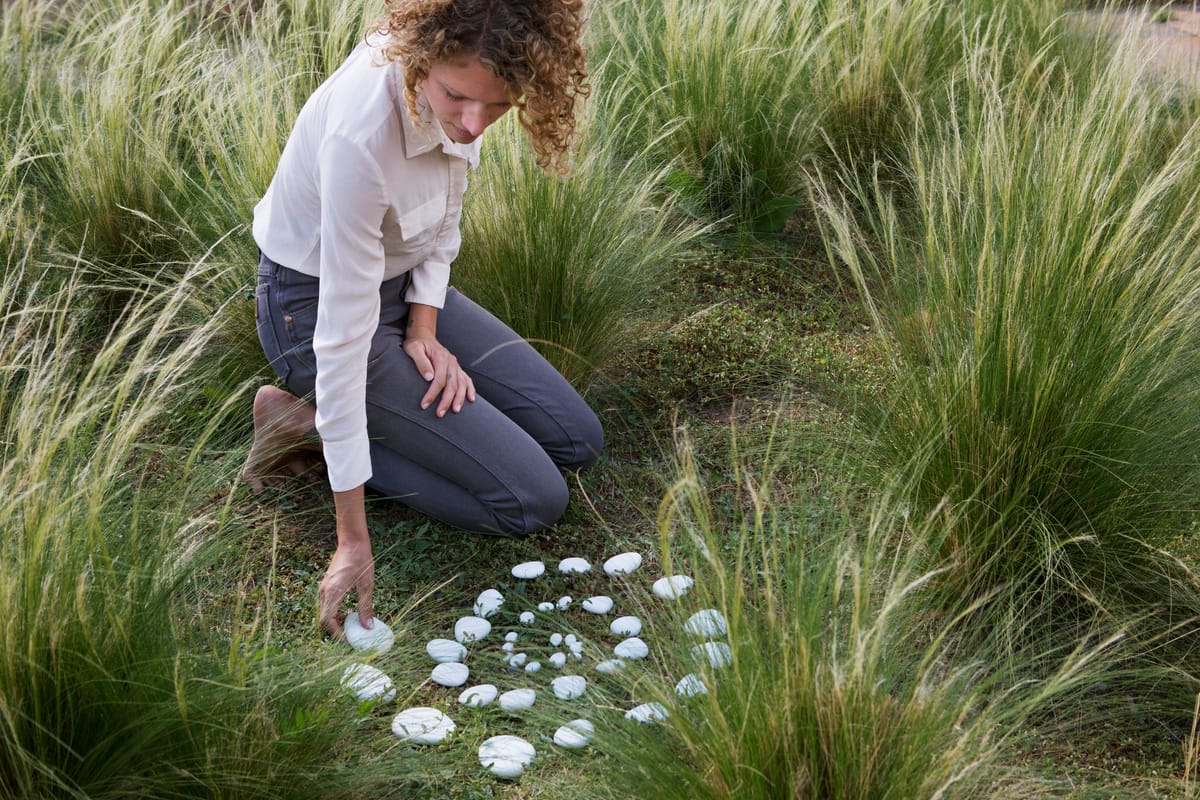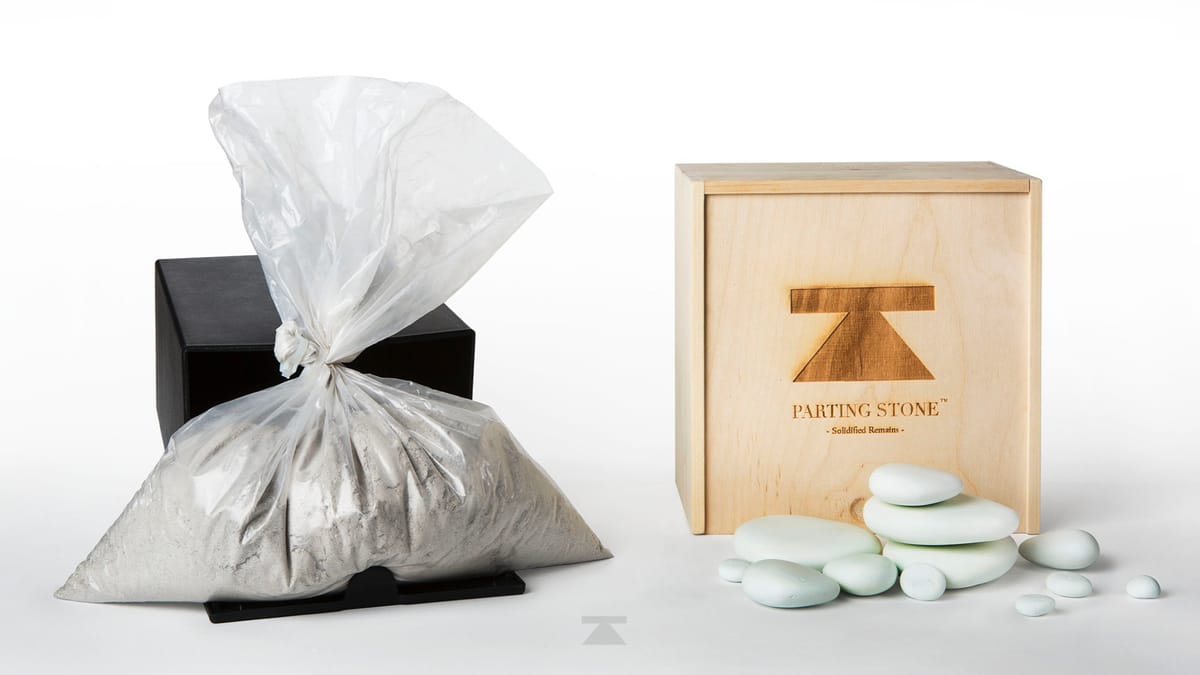Eco-Friendly Memorial Options: A Complete Guide to Sustainable Choices
Consider memorial environmental impact in your decision-making. Explore eco-friendly options and sustainable memorial choices for conscious families.

Key Takeaways
- Traditional memorial practices like cremation produce 400+ pounds of CO2 per person, while conventional burial uses toxic embalming chemicals and non-biodegradable materials
- The most environmentally friendly memorial options include natural burial, water cremation, human composting, and solidified remains, each offering different levels of permanence and environmental impact
- Ash scattering, while perceived as eco-friendly, can disrupt soil pH balance and introduce heavy metals into ecosystems
- Solidified remains provide a permanent memorial while containing cremated remains to prevent environmental disruption, with no additives or ongoing ecological footprint
- Making an environmentally conscious choice means balancing personal values, desired permanence, budget considerations, and genuine environmental impact data
Reflections on love, loss, and the ways we carry them.
For many families I’ve met through the years, choosing a memorial option after the death of someone they love is one of the hardest decisions they ever make. And when environmental stewardship has been a lifelong value, either for you or for the person you’ve lost—the decision carries an added emotional weight. You’re grieving, you’re overwhelmed, and yet you still want to do right by your person and by the earth. That tension is real, and it deserves tenderness, not pressure.
One of my clients, Liza, came to me after her father, an agronomist and lifelong environmental advocate, passed away. She told me, almost in tears, “I just don’t want to harm the soil he spent his whole life protecting.” She assumed scattering his ashes in his favorite hiking trail was the most natural choice, but after learning how cremated remains can alter soil chemistry and affect plant life, she felt torn. When she discovered the option of solidified remains, something eased. Holding one of her father’s stones, she whispered, “This feels like honoring him without hurting the land he loved.”
Families like Liza’s remind me that grief isn’t just emotional. It’s ethical, spiritual, and deeply personal.
Environmentally conscious memorial options like natural burial, water cremation, human composting, and cremation solidification, give families a way to honor their loved one without environmental harm. Solidified remains, in particular, offer permanence without ecological impact and a tangible connection that brings comfort.
There is no perfect choice, only the choice that aligns with your values, your story, and your love. And in grief, that is enough.
Cathy Sanchez Babao
Parting Stone Grief Coach
When someone you love dies, you're asked to make countless decisions while navigating profound grief. If environmental stewardship has been central to your life, or to the life of the person you've lost, choosing memorial options that honor both your loved one and the planet carries deep emotional weight. You want something permanent, something meaningful, yet you're also aware that traditional memorial practices can have significant environmental consequences. This tension between wanting to do right by your person and doing right by the earth is real, valid, and more complex than many realize.
The most environmentally friendly memorial options include natural burial, water cremation (alkaline hydrolysis), human composting, solidified remains, and carefully selected biodegradable memorials. Each option offers different environmental benefits, permanence levels, and costs, allowing families to choose based on their specific values and circumstances.
In this comprehensive guide, we'll explore the actual environmental impact of various memorial choices, including some that are commonly perceived as "green" but may have hidden ecological costs. You'll find detailed comparisons, research-backed data, and practical frameworks for making a decision that authentically reflects what matters most to you and honors your loved one's memory in a way that feels right.

A New Way to Hold Close What Matters Most
We transform cremated remains into beautiful, touchable stones that bring comfort when you need it. Something you can hold, share, and keep close.
Understanding the Environmental Impact of Traditional Memorial Options
Traditional memorial practices carry environmental footprints that many families don't fully understand until they begin researching options. The reality is more nuanced than simple "good" or "bad" categorizations.
The Carbon Cost of Cremation
Modern cremation requires sustained temperatures of 1,400-1,800°F for 2-3 hours. According to research from the Cremation Association of North America, a single cremation produces approximately 400 pounds of carbon dioxide, equivalent to driving 500 miles in an average car. Natural gas consumption per cremation ranges from 250-400 cubic feet. Multiply this across the 1.9 million cremations performed annually in the United States, and the collective carbon footprint becomes substantial.
Mercury emissions present an additional concern. Dental amalgam fillings vaporize during cremation, releasing mercury into the atmosphere. The UK Environment Agency reports that crematoria account for approximately 16% of UK mercury emissions, prompting regulatory requirements for filtration systems in many countries.
Traditional Burial's Chemical Legacy
Conventional burial introduces different environmental challenges. The Green Burial Council documents that traditional embalming uses formaldehyde, a known carcinogen, at concentrations of 5-37%. Each year, American funeral practices introduce approximately 827,060 gallons of embalming fluid into the soil. These chemicals persist in groundwater and soil for years.
Casket production consumes significant resources. Hardwood caskets require old-growth timber, while metal caskets use steel and copper. Concrete burial vaults, used in approximately 65% of conventional burials to prevent grave collapse, represent tons of concrete per burial. The National Funeral Directors Association estimates that annual U.S. burials place 90,272 tons of steel, 2,700 tons of copper and bronze, and over 30 million board feet of hardwood into the ground.

The Hidden Impact of Memorial Products
Even after disposition, memorial products carry environmental considerations. Urns made from ceramics, metals, or non-biodegradable plastics persist indefinitely in landfills when families eventually discard them. Manufacturing these products requires energy, raw materials, and transportation. Granite and marble memorials require quarrying, cutting, and transportation, each energy-intensive process.
As Cheryl Anderson from Phoenix, Arizona 🖤 shares: "We wanted to honor my father's commitment to environmental conservation. He spent his career as a park ranger teaching others about protecting natural spaces. Choosing how to memorialize him felt like the last way we could honor that dedication."
Ash Scattering: Not as Green as It Appears
Many families assume scattering cremated remains is the most environmentally neutral option. However, cremated remains aren't simply carbon. They contain calcium phosphate, sodium, potassium, and trace heavy metals absorbed throughout life, including mercury, lead, and cadmium.
When concentrated in a single location, these substances alter soil chemistry. Research published in ScienceDirect found that cremated remains raise soil pH by 2-3 points in concentrated areas, creating alkaline conditions that stress acid-loving plants. High calcium concentrations can bind with soil phosphorus, making it unavailable to plants.
Popular scattering locations, including beaches, mountains, and memorial gardens, often receive repeated ash deposits. The National Park Service has documented soil composition changes in areas with frequent ash scattering, noting negative impacts on native vegetation. Water scattering introduces similar concerns for aquatic ecosystems, where calcium and mineral concentrations can affect water chemistry and aquatic life.

Most Eco-Friendly Memorial Options: A Comprehensive Analysis
Understanding your choices requires looking beyond marketing claims to actual environmental impact data. Here's what current research tells us about sustainable memorial options.
| Option | Environmental Impact | Permanence | Approximate Cost | Best For |
|---|---|---|---|---|
| Natural/Green Burial | Minimal; biodegradable materials only | High (location-based) | $2,000-$4,000 | Those wanting earth integration |
| Water Cremation | 90% less energy than flame; no emissions | Medium (ashes remain) | $2,000-$3,500 | Eco-conscious with ash preference |
| Human Composting | Nutrient-rich soil creation; minimal energy | Medium (soil created) | $5,500-$7,000 | Those comfortable with transformation |
| Solidified Remains | No additives; contained memorial | High (permanent stones) | $2,495 | Those wanting tangible, shareable memorial |
| Memorial Reefs | Supports marine life; concrete required | High (ocean-based) | $3,000-$7,000 | Ocean conservation advocates |
| Tree Planting Memorial | Carbon sequestration; requires land | High (living memorial) | $1,000-$3,000 | Those with suitable land access |
Natural and Green Burial
Natural burial represents the most traditional human disposition method, now marketed as innovative. Bodies rest in biodegradable caskets or shrouds, without embalming, in protected conservation lands. The Green Burial Council certifies burial grounds that prohibit vaults, non-biodegradable materials, and chemical preservation.
Environmental benefits include zero toxic chemical introduction, complete biodegradability within 1-2 years, and conservation land protection through burial ground designation. Many natural burial grounds double as wildlife preserves, directly linking memorial choices to habitat protection.
Challenges include limited availability, particularly in urban areas. Only approximately 300 certified green burial sites exist across the United States. Transportation to distant sites can offset environmental benefits through fuel consumption.
Water Cremation (Alkaline Hydrolysis)
Water cremation, or alkaline hydrolysis, uses water, alkaline solution, heat, and pressure to accelerate natural decomposition. Research from funeral industry analysts shows the process uses 90% less energy than flame cremation and produces no direct emissions.
The process returns bone fragments similar to flame cremation, requiring processing into cremated remains. Liquid byproduct, described as sterile and safe by proponents, enters wastewater treatment systems, raising questions from some environmental scientists about long-term cumulative effects.
Currently legal in 28 U.S. states, availability continues expanding. The process costs typically range between $2,000-$3,500, comparable to flame cremation plus urn costs.
Human Composting (Natural Organic Reduction)
The newest option, human composting, transforms bodies into approximately one cubic yard of nutrient-rich soil over 30-60 days. Washington State University research demonstrated the process safely and effectively breaks down all organic material, including bones, producing usable compost.
Environmental advantages include minimal energy use, no emissions, and creation of nutrient-rich soil that families can use in gardens or donate to conservation projects. The process sequesters carbon rather than releasing it.
Currently legal in Washington, Colorado, Oregon, Vermont, California, and New York, with additional states considering legislation. Costs range from $5,500-$7,000. Cultural and religious considerations make this option unsuitable for many families.
Jennifer Martinez from Portland, Oregon 🖤 reflects: "When my mother passed, we chose human composting because she was a master gardener. Now part of her nourishes the plants in my garden. Every time I'm out there, I feel connected to her passion and her life."

Memorial Reefs
Memorial reefs incorporate cremated remains into concrete structures designed to support marine ecosystems. Companies like Eternal Reefs create reef balls that provide surfaces for coral attachment and habitats for fish.
Environmental benefits include marine habitat creation in areas where natural reefs have degraded. However, concrete production carries environmental costs, including CO2 emissions during manufacturing. The net environmental benefit depends on long-term ecosystem development at placement sites.
Costs range from $3,000-$7,000 depending on reef size. Families must transport remains to coastal placement sites, and memorial visits require boat access, limiting physical connection for many.
Tree Planting Memorials
Biodegradable urns containing tree seeds or saplings offer living memorials. Companies provide specialized urns that biodegrade while supporting young tree growth with cremated remains as nutrients.
Benefits include carbon sequestration, habitat creation, and a living memorial that grows over time. Challenges include ensuring appropriate planting locations, ongoing care requirements, and the reality that cremation has already occurred, carrying its environmental cost.
David Reyes from Denver, Colorado 🖤 shares: "We planted a tree with my dad's remains in his favorite hiking area. But later, I wished I had something I could hold, something tangible. The tree is beautiful, but on hard days, I wanted Dad closer."

Why Ash Scattering Isn't as Eco-Friendly as Many Believe
The perception of ash scattering as environmentally neutral deserves closer examination. While seeming to return remains "to nature," concentrated deposits of processed cremated remains introduce substances that ecosystems didn't evolve to handle.
Soil Chemistry Disruption
Cremated remains consist primarily of calcium phosphate, creating highly alkaline material with pH values of 10-12. When introduced to soil, this dramatically alters local pH balance. Soil science research demonstrates that pH changes of even 1-2 points significantly affect nutrient availability and microbial activity.
Native plants adapted to specific pH ranges struggle in altered conditions. Acid-loving plants like rhododendrons, blueberries, and many forest understory species cannot absorb nutrients in alkaline conditions. In popular scattering locations receiving repeated deposits, visible plant stress and species composition changes occur over time.
Heavy Metal Accumulation
Throughout life, human bodies accumulate trace amounts of heavy metals from environmental exposure, dental work, and medical treatments. These concentrate in cremated remains. Studies analyzing cremated remains composition find detectable levels of mercury, lead, cadmium, chromium, and arsenic.
While individual deposits contain small quantities, popular scattering locations receive hundreds or thousands of deposits over years. Environmental monitoring in heavily used scattering areas shows measurably elevated heavy metal concentrations in soil compared to control sites.
Mercury from dental amalgams represents particular concern. While modern crematory mercury filtration reduces atmospheric emissions, mercury remains in the cremated remains themselves. When scattered, it enters soil where it can transform into methylmercury, a highly toxic form that biomagnifies through food chains.
Regulatory Restrictions Reflect Environmental Concerns
Legal restrictions on ash scattering aren't arbitrary. The National Park Service restricts or prohibits scattering in many parks specifically because of documented environmental impacts. Restrictions typically increase in areas with sensitive ecosystems, rare species, or heavy visitor use.
Water scattering faces similar restrictions. The EPA regulates ash scattering in ocean waters under the Marine Protection, Research and Sanctuaries Act, requiring scattering occur at least three nautical miles from shore. These regulations acknowledge that concentrated deposits affect marine chemistry and benthic communities.
Robert and Patricia Chen from San Diego, California 🖤 learned this firsthand: "We wanted to scatter my mother-in-law's ashes in her favorite tide pools, but it's prohibited because of the sensitive ecosystem. We needed another option that felt right environmentally but gave us something permanent."

How Solidified Remains Offer Environmental Benefits
Cremation solidification represents a relatively new option that addresses both environmental concerns and the human need for tangible connection. Understanding the process and its environmental implications helps families evaluate whether it aligns with their values.
Environmental Advantages of Containment
The primary environmental benefit comes from containment. By transforming cremated remains into stable, contained form, solidification prevents the introduction of concentrated minerals and trace metals into ecosystems. There's no pH disruption, no heavy metal leaching, no alteration of soil or water chemistry.
This matters particularly for families who already chose cremation before learning about scattering's environmental implications. Solidification provides an environmentally responsible option for cremated remains already in existence, preventing environmental introduction while creating a permanent, meaningful memorial.
The process produces no ongoing environmental footprint. Once created, solidified remains require no maintenance, no eventual disposal, no degradation over time. Families can keep them indefinitely without environmental concern. They're shareable among family members, travelable, and displayable in ways that honor both the person and environmental values.
Parting Stone pioneered this cremation solidification industry and has served over 10,000 families since 2019. The service costs $2,495 for human remains solidification, transforming all cremated remains into stones that families describe as beautiful, comforting, and easier to integrate into daily life than traditional ashes.
Sarah Mitchell from Boulder, Colorado 🖤 explains: "My husband and I are both environmental scientists. When my mom died, we agonized over what to do with her remains. Scattering felt wrong once we understood the impact. The solidified remains gave us something permanent that doesn't harm the places she loved. I keep several stones, my brother has some, and we each have a tangible connection to her."
Comparing to Urn Storage
Traditional urn storage avoids environmental introduction but creates different challenges. Many families find urns difficult to integrate into home spaces, leading to storage in closets, basements, or garages. This often feels disrespectful, creating guilt and unresolved feelings about what to do with remains.
Urns themselves represent environmental costs. Ceramic, metal, and wooden urns require manufacturing, materials, and transportation. When families eventually discard them, they enter landfills. Biodegradable urns designed for burial still require eventual disposition decisions.
Solidified remains need no container, require no eventual disposition, and integrate naturally into living spaces. Families report keeping stones in meaningful locations, carrying them when traveling to significant places, and finding comfort in their tangibility during difficult moments.
Michael Torres from Santa Fe, New Mexico 🖤 shares: "Having Dad's solidified remains means I can take part of him camping in places we used to go together. That physical connection helps me feel close to him in the landscapes that shaped who he was. I couldn't do that with an urn of ashes."

Making an Environmentally Conscious Memorial Decision
Choosing environmental memorial options requires balancing multiple factors, none of which have objectively "correct" answers. What matters is finding the choice that authentically aligns with your values, circumstances, and relationship with the person who died.
A Framework for Decision-Making
Consider these questions as you evaluate options:
- Environmental Impact: What specific environmental concerns matter most to you? Carbon emissions? Chemical introduction? Habitat protection? Different options address different environmental priorities. Understanding your specific values helps narrow choices.
- Permanence and Connection: What kind of ongoing relationship do you want with your loved one's memorial? Some people find comfort in physical objects they can see and touch daily. Others prefer living memorials or the idea of return to earth. Neither is better; they're different ways of maintaining connection.
- Practical Considerations: What access do you have to different options? Natural burial sites may be distant. Human composting remains unavailable in most states. Water cremation isn't universally offered. Practical accessibility legitimately influences choices.
- Budget Reality: Memorial costs vary significantly. While environmental values matter, so does financial reality, particularly when unexpected death strains family resources. Being honest about budget constraints helps identify genuine options rather than ideal but unaffordable ones.
- Family Agreement: If multiple family members share decision-making, finding consensus matters. Some options allow partial solutions, such as solidifying most remains while scattering a small amount in a meaningful place, allowing different family members' needs to be honored.
Questions to Ask Providers
When investigating specific options, these questions help evaluate environmental claims:
- What independent certifications or third-party verification supports environmental claims?
- What happens to byproducts or waste from the process?
- How much energy does the process require, and what's the energy source?
- What materials are used, and are they sustainably sourced?
- What's the long-term environmental impact beyond initial disposition?
Reputable providers welcome these questions and provide transparent answers. Vague responses or resistance to specifics suggests less rigorous environmental standards than marketing materials claim.
Recognizing Marketing vs. Substance
The memorial industry increasingly uses "green," "eco-friendly," and "sustainable" terminology. Some claims represent genuine environmental benefits. Others amount to greenwashing, applying environmental language to conventional practices with minimal actual improvement.
Look for specific, measurable environmental advantages rather than general claims. "Uses biodegradable materials" means more than "eco-friendly option." "Reduces CO2 emissions by 90% compared to flame cremation" provides verifiable information. "Green choice for conscious families" offers no substantive content.
Organizations like the Green Burial Council, Funeral Consumers Alliance, and academic research institutions provide more reliable environmental impact information than individual company marketing materials.
Linda Nakamura from Seattle, Washington 🖤 reflects: "I spent weeks researching every option. Some were genuinely environmentally sound. Others just used green language without substance. Taking time to understand the actual impacts helped me feel confident in my choice rather than wondering if I'd been manipulated by marketing."

Conclusion
Choosing memorial options that honor both your loved one and your environmental values requires navigating complex information during an emotionally difficult time. There is no single "right" answer that works for everyone. What matters is finding the choice that authentically reflects your values, circumstances, and relationship with the person who died.
The research shows that some options perceived as environmentally neutral, like ash scattering, carry more ecological impact than commonly understood. Others, like natural burial and water cremation, offer genuine environmental benefits with different trade-offs in terms of permanence, cost, and availability. Newer options like human composting and solidified remains provide alternatives that weren't available to previous generations.
Whatever you choose, making an informed decision based on actual environmental impact data, rather than assumptions or marketing claims, allows you to move forward with confidence. Your choice becomes part of how you honor your person's life and values, including their care for the earth.
If you're interested in learning more about solidified remains as an environmentally responsible option that provides permanent, tangible memorial stones, resources are available to help you understand whether this choice aligns with your values and needs.
Frequently Asked Questions
Is cremation bad for the environment?
Cremation produces approximately 400 pounds of CO2 per person and uses 250-400 cubic feet of natural gas, making it moderately impactful environmentally. However, it uses significantly less land than conventional burial and avoids introducing embalming chemicals into soil. Water cremation offers a more environmentally friendly alternative, using 90% less energy than flame cremation.
What is the carbon footprint of cremation?
A single flame cremation produces approximately 400 pounds of carbon dioxide, equivalent to driving an average car 500 miles. This comes from natural gas consumption during the 2-3 hour process maintaining temperatures of 1,400-1,800°F. Water cremation reduces this impact by approximately 90%, while conventional burial's carbon footprint depends on embalming chemicals, casket materials, and transportation factors.
Are cremated ashes harmful to the environment?
Cremated remains can harm ecosystems when scattered in concentrated amounts. They contain high levels of calcium phosphate that raises soil pH by 2-3 points, stressing acid-loving plants. They also contain trace heavy metals like mercury, lead, and cadmium that accumulate in popular scattering locations. These effects are why the National Park Service restricts scattering in many protected areas with sensitive ecosystems.
What is the most eco-friendly way to be buried?
Natural or green burial represents the most environmentally friendly burial option, using biodegradable materials without embalming, vaults, or chemical preservation. Bodies decompose naturally, returning nutrients to soil while burial sites often function as protected conservation land. Human composting offers an even more environmentally beneficial option where legal, creating nutrient-rich soil while sequestering carbon and using minimal energy.
Can you scatter ashes anywhere legally?
No, ash scattering faces numerous legal restrictions. Federal law prohibits scattering on most federal lands without permits. National and state parks have specific regulations, often prohibiting scattering entirely in sensitive areas. Ocean scattering must occur at least three nautical miles from shore under EPA regulations. Private property requires owner permission. These restrictions exist partly because of environmental concerns about concentrated ash deposits' ecological impacts.
How does solidification of cremated remains work?
Solidification transforms cremated remains into smooth, stone-like pieces through a patented process using heat and pressure to restructure the calcium and mineral composition. The process requires no additives or chemicals, simply reorganizing the existing material into stable, solid form. This creates 40-80+ permanent stones that families can keep, share, or travel with while preventing environmental introduction of remains into ecosystems.
What happens to embalming fluid in the ground?
Embalming fluid, primarily formaldehyde at concentrations of 5-37%, persists in soil and groundwater for years after burial. It leaches gradually from bodies into surrounding soil, contaminating groundwater in some cases. Formaldehyde is a known carcinogen, and its environmental persistence represents one of the primary concerns with conventional burial practices. Natural burial avoids this entirely by prohibiting embalming.
References
Cremation Association of North America. (2024). Cremation industry statistics and trends. https://www.cremationassociation.org/
Environmental Protection Agency. (2024). Ocean dumping: Burial at sea. https://www.epa.gov/ocean-dumping/burial-sea
Green Burial Council. (2024). What is green burial? Standards and certification. https://www.greenburialcouncil.org/
National Funeral Directors Association. (2024). Cremation and burial statistics. https://www.nfda.org/
National Park Service. (2024). Scattering ashes policy and environmental guidelines. https://www.nps.gov/
Soil Science Society of America. (2024). Soil pH and nutrient availability. https://www.soils.org/
UK Environment Agency. (2024). Mercury emissions from crematoria. https://www.gov.uk/
Washington State University. (2023). Natural organic reduction research findings. https://www.wsu.edu/
Wiley Online Library. (2024). Journal of Environmental Quality: Soil chemistry studies. https://acsess.onlinelibrary.wiley.com/journal/jeq









